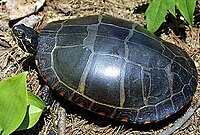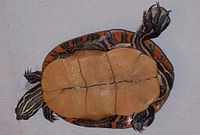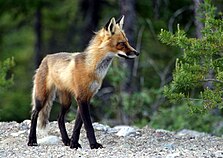The painted turtle (Chrysemys picta) is the most widespread native turtle of North America. It lives in slow-moving fresh waters, from southern Canada to Louisiana and northern Mexico, and from the Atlantic to the Pacific. The turtle is the only species of the genusChrysemys, which is part of the pond turtle family Emydidae. Fossils show that the painted turtle existed 15 million years ago. Four regionally based subspecies (the eastern, midland, southern, and western) evolved during the last ice age.
The adult painted turtle female is 10–25 cm (4–10 in) long; the male is smaller. The turtle's top shell is dark and smooth, without a ridge. Its skin is olive to black with red, orange, or yellow stripes on its extremities. The subspecies can be distinguished by their shells: the eastern has straight-aligned top shell segments; the midland has a large gray mark on the bottom shell; the southern has a red line on the top shell; the western has a red pattern on the bottom shell.
The turtle eats aquatic vegetation, algae, and small water creatures including insects, crustaceans, and fish. Although they are frequently consumed as eggs or hatchlings by rodents, canines, and snakes, the adult turtles' hard shells protect them from most predators. Reliant on warmth from its surroundings, the painted turtle is active only during the day when it basks for hours on logs or rocks. During winter, the turtle hibernates, usually in the mud at the bottom of water bodies. The turtles mate in spring and autumn. Females dig nests on land and lay eggs between late spring and mid-summer. Hatched turtles grow until sexual maturity: 2–9 years for males, 6–16 for females.
In the traditional tales of Algonquian tribes, the colorful turtle played the part of a trickster. In modern times, four U.S. states have named the painted turtle their official reptile. While habitat loss and road killings have reduced the turtle's population, its ability to live in human-disturbed settings has helped it remain the most abundant turtle in North America. Adults in the wild can live for more than 55 years.
Description
The painted turtle's shell is 10–25 cm (4–10 in) long, oval, smooth with little grooves where the large scale-like plates overlap, and flat-bottomed.[7][nb 2][8][9] The color of the top shell (carapace) varies from olive to black. Darker specimens are more common where the bottom of the water body is darker. The bottom shell (plastron) is yellow, sometimes red, sometimes with dark markings in the center. Similar to the top shell, the turtle's skin is olive to black, but with red and yellow stripes on its neck, legs, and tail.[10][11] As with other pond turtles, such as the bog turtle, the painted turtle's feet are webbed to aid swimming.[12][13][14]
The head of the turtle is distinctive. The face has only yellow stripes, with a large yellow spot and streak behind each eye, and on the chin two wide yellow stripes that meet at the tip of the jaw.[7][9][10] The turtle's upper jaw is shaped into an inverted "V" (philtrum), with a downward-facing, tooth-like projection on each side.[15]
The hatchling has a proportionally larger head, eyes, and tail, and a more circular shell than the adult.[16][17] The adult female is generally longer than the male, 10–25 cm (4–10 in) versus 7–15 cm (3–6 in).[10][18] For a given length, the female has a higher (more rounded, less flat) top shell.[19] The female weighs around 500 g (18 oz) on average, against the males' average adult weight of roughly 300 g (11 oz).[20] The female's greater body volume supports her egg-production.[21] The male has longer foreclaws and a longer, thicker tail, with the anus (cloaca) located further out on the tail.[7][8][9][22]
Subspecies
Although the subspecies of painted turtle intergrade (blend together) at range boundaries[23] they are distinct within the hearts of their ranges.[24]
- The male eastern painted turtle (C. p. picta) is 13–17 cm (5–7 in) long, while the female is 14–17 cm (6–7 in). The upper shell is olive green to black and may possess a pale stripe down the middle and red markings on the periphery. The segments (scutes) of the top shell have pale leading edges and occur in straight rows across the back, unlike all other North American turtles, including the other three subspecies of painted turtle, which have alternating segments.[24] The bottom shell is plain yellow or lightly spotted. Sometimes as few as one dark grey spot near the lower center of the shell.[25]
- The midland painted turtle (C. p. marginata) is 10–25 cm (4–10 in) long.[26] The centrally located midland is the hardest to distinguish from the other three subspecies.[24] Its bottom shell has a characteristic symmetrical dark shadow in the center which varies in size and prominence.[27]
- The southern painted turtle (C. p. dorsalis), the smallest subspecies, is 10–14 cm (4–6 in) long.[28] Its top stripe is a prominent red,[24] and its bottom shell is tan and spotless or nearly so.[29]
- The largest subspecies is the western painted turtle (C. p. bellii), which grows up to 26.6 cm (10 in) long.[30][31] Its top shell has a mesh-like pattern of light lines,[32] and the top stripe present in other subspecies is missing or faint. Its bottom shell has a large colored splotch that spreads to the edges (further than the midland) and often has red hues.[32]
| Eastern painted turtle C. p. picta | Midland painted turtle C. p. marginata | Southern painted turtle C. p. dorsalis | Western painted turtle C. p. bellii |
|---|---|---|---|
 |  |  |  |
 |  |  |  |
Similar species
The painted turtle has a very similar appearance to the red-eared slider (the most common pet turtle) and the two are often confused. The painted turtle can be distinguished because it is flatter than the slider. Also, the slider has a prominent red marking on the side of its head (the "ear") and a spotted bottom shell, both features missing in the painted turtle.[33]
| Painted turtle | Red-eared slider |
|---|---|
 |  |
Ecology
Diet
The painted turtle hunts along water bottoms. It quickly juts its head into and out of vegetation to stir potential victims out into the open water, where they are pursued.[34] The turtle holds large prey in its mouth and tears the prey apart with its forefeet. It also consumes plants and skims the surface of the water with its mouth open to catch small particles of food.[34]
Although all subspecies of painted turtle eat both plants and animals, their specific diets vary.[34][35]
- The eastern painted turtle's diet is the least studied. It prefers to eat in the water, but has been observed eating on land. The fish it consumes are typically dead or injured.[35]
- The midland painted turtle eats mostly aquatic insects and both vascular and non-vascular plants.[36]
- The southern painted turtle's diet changes with age. Juveniles' diet consists of 13% vegetation, while the adults eat 88% vegetation. This perhaps shows that the turtle prefers small larvae and other prey, but can only obtain significant amounts while young.[37] The reversal of feeding habits with age has also been seen in the false map turtle, which inhabits some of the same range. The most common plants eaten by adult southern painted turtles are duckweed and algae, and the most common prey items are dragonfly larvae and crayfish.[38]
- The western painted turtle's consumption of plants and animals changes seasonally. In early summer, 60% of its diet comprises insects. In late summer, 55% includes plants.[39] Of note, the western painted turtle aids in the dispersal of white water-lily seeds. The turtle consumes the hard-coated seeds, which remain viable after passing through the turtle, and disperses them through its feces.[39]
| Common foods of the painted turtle | |||
 Crayfish |  Dragonfly larva |  American water lily |  Duckweed (water surface) |
Predators
Painted turtles are most vulnerable to predators when young.[40] Nests are frequently ransacked and the eggs eaten by garter snakes, crows, chipmunks, thirteen-lined ground and gray squirrels, skunks, groundhogs, raccoons, badgers, gray and red fox, and humans.[40] The small and sometimes bite-size, numerous hatchlings fall prey to water bugs, bass, catfish, bullfrogs, snapping turtles, three types of snakes (copperheads, racers and water snakes), herons, rice rats, weasels, muskrats, minks, and raccoons. As adults, the turtles' armored shells protect them from many potential predators, but they still occasionally fall prey to alligators, ospreys, crows, red-shouldered hawks, bald eagles, and especially raccoons.[40]
Painted turtles defend themselves by kicking, scratching, biting, or urinating.[40] In contrast to land tortoises, painted turtles can right themselves if they are flipped upside down.[41]
| Important predators of the painted turtle | |||||
Of eggs: Red fox |  Plains Garter Snake |  Crows | Of hatchlings: Common Snapping Turtle |  Water Bugs | Of adults: Raccoon |
Life cycle
Mating
The painted turtles mate in spring and fall in waters of 10–25 °C (50–77 °F).[42] Males start producing sperm in early spring, when they can bask to an internal temperature of 17 °C (63 °F).[43][44] Females begin their reproductive cycles in mid-summer, and ovulate the following spring.[45]
Courtship begins when a male follows a female until he meets her face-to-face.[46] He then strokes her face and neck with his elongated front claws, a gesture returned by a receptive female. The pair repeat the process several times, with the male retreating from and then returning to the female until she swims to the bottom, where they copulate.[45][46] As the male is smaller than the female, he is not dominant.[46] The female stores sperm, to be used for up to three clutches, in her oviducts; the sperm may remain viable for up to three years.[47] A single clutch may have multiple fathers.[47]
Egg-laying
Nesting is done, by the females only, between late May and mid-July.[45] The nests are vase-shaped and are usually dug in sandy soil, often at sites with southern exposures.[48]Nests are often within 200 m (220 yd) of water, but may be as far away as 600 m (660 yd), with older females tending to nest further inland. Nest sizes vary depending on female sizes and locations but are about 5–11 cm (2–4 in) deep.[48] Females may return to the same sites several consecutive years, but if several females make their nests close together, the eggs become more vulnerable to predators.[48]
The female's optimal body temperature while digging her nest is 29–30 °C (84–86 °F).[48] If the weather is unsuitable, for instance a too hot night in the Southeast, she delays the process until later at night.[48] Painted turtles in Virginia have been observed waiting three weeks to nest because of a hot drought.[49]
While preparing to dig her nest, the female sometimes exhibits a mysterious preliminary behavior. She presses her throat against the ground of different potential sites, perhaps sensing moisture, warmth, texture, or smell, although her exact motivation is unknown. She may further temporize by excavating several false nests[48] as the wood turtles also do.[50]
The female relies on her hind feet for digging. She may accumulate so much sand and mud on her feet that her mobility is reduced, making her vulnerable to predators. To lighten her labors, she lubricates the area with her bladder water.[48] Once the nest is complete, the female deposits into the hole. The freshly laid eggs are white, elliptical, porous, and flexible.[51] From start to finish, the female's work may take four hours. Sometimes she remains on land overnight afterwards, before returning to her home water.[48]
Females can lay five clutches per year, but two is a normal average after including the 30–50% of a population's females that do not produce any clutches in a given year.[48] In some northern populations, no females lay more than one clutch per year.[48] Bigger females tend to lay bigger eggs and more eggs per clutch.[52] Clutch sizes of the subspecies vary, although the differences may reflect different environments, rather than different genetics. The two more northerly subspecies, western and midland, are larger and have more eggs per clutch—11.9 and 7.6, respectively—than the two more southerly subspecies, southern (4.2) and eastern (4.9). Within subspecies, also, the more northerly females lay larger clutches.[48]
Growth
Incubation lasts 72–80 days in the wild[45] and for a similar period in artificial conditions.[49] In August and September, the young turtle breaks out from its egg, using a special projection of its jaw called the egg tooth.[53] Not all offspring leave the nest immediately, though.[45] Hatchlings north of a line from Nebraska to northern Illinois to New Jersey[54]typically arrange themselves symmetrically[55] in the nest and overwinter to emerge the following spring.[45]
The hatchling's ability to survive winter in the nest has allowed the painted turtle to extend its range further north than any other American turtle. The painted turtle is genetically adapted to survive extended periods of subfreezing temperatures with blood that can remain supercooled and skin that resists penetration from ice crystals in the surrounding ground.[54] The hardest freezes nevertheless kill many hatchlings.[45]
Immediately after hatching, turtles are dependent on egg yolk material for sustenance.[55] About a week to a week and a half after emerging from their eggs (or the following spring if emergence is delayed), hatchlings begin feeding to support growth. The young turtles grow rapidly at first, sometimes doubling their size in the first year. Growth slows sharply at sexual maturity and may stop completely.[56] Likely owing to differences of habitat and food by water body, growth rates often differ from population to population in the same area. Among the subspecies, the western painted turtles are the quickest growers.[57]
Females grow faster than males overall, and must be larger to mature sexually.[56] In most populations males reach sexual maturity at 2–4 years old, and females at 6–10.[44] Size and age at maturity increase with latitude;[18] at the northern edge of their range, males reach sexual maturity at 7–9 years of age and females at 11–16.[46]
Behavior
Daily routine and basking
A cold-blooded reptile, the painted turtle regulates its temperature through its environment, notably by basking. All ages bask for warmth, often alongside other species of turtle. Sometimes more than 50 individuals are seen on one log together.[58] Turtles bask on a variety of objects, often logs, but have even been seen basking on top of common loons that were covering eggs.[59]
The turtle starts its day at sunrise, emerging from the water to bask for several hours. Warmed for activity, it returns to the water to forage.[60] After becoming chilled, the turtle re-emerges for one to two more cycles of basking and feeding.[61] At night, the turtle drops to the bottom of its water body or perches on an underwater object and sleeps.[60]
To be active, the turtle must maintain an internal body temperature between 17–23 °C (63–73 °F). When fighting infection, it manipulates its temperature up to 5 °C (8 °F) higher than normal.[58]
Seasonal routine and hibernation
In the spring, when the water reaches 15–18 °C (59–64 °F), the turtle begins actively foraging. However, if the water temperature exceeds 30 °C (86 °F), the turtle will not feed. In fall, the turtle stops foraging when temperatures drop below the spring set-point.[34]
During the winter, the turtle hibernates. In the north, the inactive season may be as long as from October to March, while the southernmost populations may not hibernate at all.[62] While hibernating, the body temperature of the painted turtle averages 6 °C (43 °F).[63] Periods of warm weather bring the turtle out of hibernation, and even in the north, individuals have been seen basking in February.[64]
The painted turtle hibernates by burying itself, either on the bottom of a body of water, near water in the shore-bank or the burrow of a muskrat, or in woods or pastures. When hibernating underwater, the turtle prefers shallow depths, no more than 2 m (7 ft). Within the mud, it may dig down an additional 1 m (3 ft).[63] In this state, the turtle does not breathe, although if surroundings allow, it may get some oxygen through its skin.[65] The species is one of the best-studied vertebrates able to survive long periods without oxygen. Adaptations of its blood chemistry, brain, heart, and particularly its shell allow the turtle to survive extreme lactic acid buildup while oxygen-deprived.[66]
Movement
Searching for water, food, or mates, the painted turtles travel up to several kilometers at a time.[67] During summer, in response to heat and water-clogging vegetation, the turtles may vacate shallow marshes for more permanent waters.[67] Short overland migrations may involve hundreds of turtles together.[62] If heat and drought are prolonged, the turtles will bury themselves and, in extreme cases, die.[68]
Foraging turtles frequently cross lakes or travel linearly down creeks.[69] Daily crossings of large ponds have been observed.[68] Tag and release studies show that sex also drives turtle movement. Males travel the most, up to 26 km (16 mi), between captures; females the second most, up to 8 km (5 mi), between captures; and juveniles the least, less than 2 km (1.2 mi), between captures.[67] Males move the most and are most likely to change wetlands because they seek mates.[68]
The painted turtles, through visual recognition, have homing capabilities.[67] Many individuals can return to their collection points after being released elsewhere, trips that may require them to traverse land. One experiment placed 98 turtles varying several-kilometer distances from their home wetland; 41 returned. When living in a single large body of water, the painted turtles can home from up to 6 km (4 mi) away. Females may use homing to help locate suitable nesting sites.







No comments:
Post a Comment